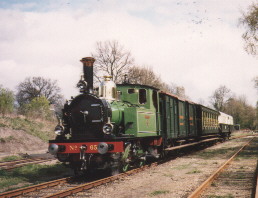NS series 8100
| NS series 8100 ČSD 214.0500 |
|
|---|---|
| Numbering: | at NS: 8.101-8.130 at ČSD: 214.0500 |
| Number: | 30th |
| Manufacturer: | Machinefabriek Breda
Centrale Werkplaats Tilburg |
| Year of construction (s): | 1901-1907 |
| Retirement: | after 1945 |
| Type : | B n2t |
| Gauge : | 1435 mm ( standard gauge ) |
| Length over buffers: | 7,493 mm |
| Height: | 4,200 mm |
| Fixed wheelbase: | 2,200 mm |
| Total wheelbase: | 2,200 mm |
| Smallest bef. Radius: | 40 m |
| Service mass: | 33 t |
| Friction mass: | 33 t |
| Wheel set mass : | 16.5 t |
| Top speed: | 45 km / h |
| Starting tractive effort: | 5.6 Mp |
| Driving wheel diameter: | 1,100 mm |
| Control type : | Walschaert |
| Number of cylinders: | 2 |
| Cylinder diameter: | 370 mm |
| Piston stroke: | 480 mm |
| Boiler overpressure: | 12 bar |
| Grate area: | 1.23 m² |
| Evaporation heating surface: | 62.5 m² (in contact with water) |
| Water supply: | 2.8 m³ |
| Fuel supply: | 0.8 m³ coal |
| Brake: | Block brake Westinghouse suction air brake |
The vehicles of the NS series 8100 were double- coupled tank locomotives of the Nederlandse Spoorwegen (NS).
history
The Staatsspoorwegen (SS) bought 10 locomotives in 1901 from the Machinefabriek Breda locomotive factory (formerly Backer & Reub, Breda, Netherlands). In the years 1903 to 1907, 17 locomotives were delivered from the central workshop ( Centrale Werkplaats ) of the SS in Tilburg , and three more from the central workshop in Zwolle . The locomotives were classified as SS 651-680. After the merger of the SS with the HSM to form the Nederlandse Spoorwegen (NS), the locomotives were classified as the 8100 series. They were intended for shunting and operation on small railways .
Their appearance resembled an English model, e.g. B. the cylinders were inclined with an inclination ratio of 1:15, although this arrangement was not necessary in view of the diameter of the drive wheels.
The first two locomotives were scrapped in 1937 (8116 and 8121). During the Second World War, after the occupation of the Netherlands, the German occupiers brought 13 machines (8101/02/05/07/08/09/14/15/20/25/26/27/29) to Germany. The 8109 was in Czechoslovakia at the end of the war in 1945 and returned to the Netherlands in 1947 after a brief deployment. Locomotive 8107 was sold to Coöperatieve Suikerfabrieken in Roosendaal in 1952 . From there it came to the Museum Buurt Spoorweg (MBS), Haaksbergen, after its retirement. Between 1947 and 1955 the remaining machines were scrapped.
technical features
The machine was built quite modern. It was equipped with an automatic and an independent traction brake of the Westinghouse type and a suction air brake . The sand spreading device was already pneumatic. With 33 t of service weight, it was able to develop a pulling force of 5.6 Mp. Its top speed was 40 km / h and it could negotiate curved tracks up to a radius of 40 m.
The controls were designed as left-hand drive.
Use in Czechoslovakia
One locomotive of this series, the 8109 , remained in Chomutov after 1945 . It was first nicknamed Vlasta and given the designation 214.0500 (Dutch sources mention number 214.001). At that time it was the first left-hand drive locomotive for the ČSD .
It remained in operation until the end of 1946 and was returned to the NS in January 1947, along with some wagons and material that had been taken away, as part of a property compensation scheme. Further data on their use cannot be found in the literature.
literature
- Jindřich Bek, Josef Janata, Jaroslav Veverka: Malý atlas lokomotiv 1, Parní lokomotivy, Nadas, Praha
- H. Waldorp: Onze nederlandse stoomlocomotieven in woord en beeld (zevende druk) , Uitgeverij De Alk BV, Alkmaar
Individual evidence
- ↑ Bek Jindrich, Janata Josef, Veverka Jaroslav: Malý atlas lokomotiv 1, Parny lokomotivy, Nadas-Verlag Prague, page 137
